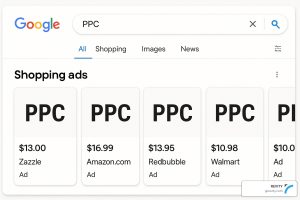Since its founding in 1994, Amazon has rapidly expanded its offerings, transforming into a premier destination for global shoppers. Today, it ranks among the largest e-commerce platforms, boasting an extensive customer base and a vast network of sellers and brands.
As the e-commerce landscape evolves, businesses grasp the importance of a robust Amazon presence. Amid the multitude of products available, distinguishing oneself poses a challenge. This is where proficient Amazon marketing strategies step in. Mere product listing no longer guarantees success; tailored marketing tactics aligned with Amazon’s ecosystem are essential for triumph.
This blog aims to demystify Amazon marketing strategies. We’ll delve into diverse aspects of Amazon marketing, offering comprehensive insights and practical guidance. Join us in uncovering the strategies that lead to triumph in the competitive realm of the Amazon marketplace!
Understanding Amazon Marketing
Amazon marketing encompasses a range of strategies and techniques designed to promote products and drive sales within the Amazon marketplace. It involves optimizing product listings, utilizing Amazon’s advertising tools, implementing effective SEO practices, managing customer reviews, and leveraging Amazon’s fulfillment options, among other tactics.
Product Listing Optimization
Product listings are the virtual shelves where your products are displayed to potential customers. Optimizing your product listings is crucial for attracting attention and converting browsers into buyers. This involves crafting compelling product titles, informative bullet points, and persuasive product descriptions.
High-quality images and engaging videos further enhance the customer’s understanding and experience with the product. Additionally, incorporating relevant keywords in your product listing is vital for improving search visibility and discoverability.
Amazon Advertising
Amazon’s advertising options provide sellers and brands with opportunities to boost product visibility and drive traffic to their listings. There are Sponsored Products, Sponsored Brands, and Sponsored Displays.
Each offers different targeting and advertising capabilities. Creating well-structured ad campaigns, selecting appropriate keywords, and setting competitive bids are key to maximizing the effectiveness of your advertising efforts.
Amazon SEO (Search Engine Optimization)
Amazon’s search algorithm, known as A9, determines the order in which products appear in search results. Optimizing your product listings for relevant keywords, customer queries, and customer behavior can significantly improve your organic search rankings. Understanding how A9 works and aligning your content with customer intent increases the likelihood of your products appearing in front of potential buyers.
Customer Reviews and Ratings
Customer reviews and ratings play a vital role in influencing purchase decisions on Amazon. Positive reviews build trust and credibility, encouraging more sales, while negative reviews can have the opposite effect. It’s essential to actively manage and encourage customer feedback, respond to reviews, and use insights to improve your products and customer experience.
Amazon Prime and Fulfillment Strategies
Leveraging Amazon Prime membership benefits can boost product visibility and improve customer loyalty. However, meeting Prime’s stringent fulfillment requirements is crucial.
You can use Fulfillment by Amazon (FBA) to benefit from Amazon’s efficient shipping and customer service or Fulfillment by Merchant (FBM) for more control over the fulfillment process. Winning the Amazon Buy Box is also essential for driving sales and increasing your chances of converting clicks into purchases.
Differentiating Between Amazon Marketing and Traditional Digital Marketing
While Amazon marketing and traditional digital marketing share similarities, they differ in their focus and approach. Traditional digital marketing drives traffic to a brand’s website or external platforms, such as social media channels or standalone e-commerce stores.
On the other hand, Amazon marketing revolves around optimizing product listings within the Amazon marketplace itself.
In traditional digital marketing, the goal is often to create brand awareness, engage with potential customers, and lead them to a conversion on external platforms. In contrast, Amazon marketing’s primary objective is to drive sales directly on the Amazon platform by maximizing visibility and conversion rates within Amazon’s ecosystem.
Recognizing the unique nature of Amazon’s ecosystem is essential for any business looking to succeed on the platform. Amazon’s algorithms, search behaviors, and customer expectations differ from those of other digital marketing channels. Therefore, a one-size-fits-all marketing approach will not yield optimal results for Amazon.
Tailoring your marketing strategies specifically for Amazon allows you to tap into the platform’s enormous customer base, leverage Amazon’s tools, and optimize your listings for maximum visibility. By understanding and adapting to Amazon’s requirements and best practices, you can gain a competitive advantage and achieve greater success in this highly competitive marketplace.

Key Elements of an Amazon Marketing Strategy
- Product Listing Optimization
Creating Compelling Product Titles, Bullet Points, and Descriptions
Crafting attention-grabbing and informative product titles is the first step in catching the eye of potential customers. Concisely highlight key product features and benefits to entice shoppers to click through.
Equally important are the bullet points and product descriptions, where you can delve deeper into the product’s unique selling points, features, and usage scenarios. Focus on addressing customer pain points and highlighting what differentiates your product from competitors.
Utilizing High-Quality Images and Videos
Visuals play a crucial role in online shopping, especially on Amazon, where customers can’t physically touch or see the products. Invest in high-resolution images that showcase the product from different angles and in use.
Including lifestyle images and infographics can help convey product benefits effectively. Video content has become increasingly popular on Amazon product pages. Use videos to demonstrate product functionality, showcase customer testimonials, or provide assembly guides.
Incorporating Relevant Keywords for Better Search Visibility
Keyword optimization is essential for improving your product’s visibility in search results. Conduct thorough keyword research to identify relevant terms and phrases that customers will likely use when searching for products like yours.
Incorporate these keywords strategically into your product titles, bullet points, and descriptions while maintaining readability and avoiding keyword stuffing. Optimizing backend keywords and hidden search terms can further enhance your product’s discoverability.
- Amazon Advertising
Overview of Amazon’s Advertising Options (Sponsored Products, Sponsored Brands, etc.)
Amazon offers several advertising options to help increase product visibility and sales. Sponsored Products ads appear in search results and product detail pages, driving traffic to specific product listings.
Sponsored Brands ads showcase your logo, custom headline, and multiple products in a banner-like format. Sponsored Display ads reach customers on and off Amazon, targeting specific audiences based on their shopping behavior.
Strategies for Setting Up Effective Ad Campaigns
Before creating ad campaigns, define your advertising goals, whether it’s increasing sales, improving brand awareness, or launching a new product. Choose relevant products to advertise and set appropriate budgets and bids.
To reach the right customers, leverage targeting options, such as keyword, product, and audience targeting. Regularly monitor and adjust your campaigns based on performance metrics to optimize results.
Measuring and Analyzing Advertising Performance
Amazon provides valuable performance metrics to gauge the success of your ad campaigns. Track key performance indicators (KPIs) like click-through rate (CTR), conversion rate, return on advertising spend (ROAS), and total sales attributed to advertising.
Use these insights to effectively refine your targeting, adjust bids, and allocate budgets. Testing different ad creatives and targeting strategies can help you identify the most successful approaches.
- Amazon SEO (Search Engine Optimization)
Understanding Amazon’s A9 Algorithm
Amazon’s A9 algorithm determines the ranking and visibility of products in search results. It considers various factors, including relevance, conversion rate, and customer satisfaction. A better understanding of how the algorithm works can help you optimize your product listings accordingly.
Tips for Improving Organic Search Rankings
To improve your product’s organic search rankings, start with comprehensive keyword research and prioritize relevant, high-converting keywords. Optimize your product titles, bullet points, and descriptions by incorporating these keywords naturally. Focus on providing accurate and detailed product information to enhance the customer’s search experience.
Best Practices for Enhancing Product Discoverability
Enhancing product discoverability involves a combination of on-page optimization and off-page strategies. Encourage customers to leave positive reviews, as higher-rated products tend to rank higher in search results. Drive external traffic to your Amazon listings through social media, email marketing, and influencer collaborations. Additionally, participating in Amazon’s advertising programs can boost visibility and help improve organic rankings.
- Customer Reviews and Ratings
The Impact of Reviews and Ratings on Product Sales
Customer reviews and ratings significantly influence purchasing decisions on Amazon. Positive reviews build trust and credibility, instilling confidence in potential buyers. Conversely, negative reviews can deter customers from making a purchase. A solid review and rating strategy can be crucial in gaining a competitive advantage.
Strategies for Encouraging Positive Reviews and Handling Negative Feedback
Offer exceptional customer service and prompt communication to encourage positive reviews. Implement post-purchase follow-ups to request feedback and address any issues proactively. Respond promptly and professionally to negative reviews, showing customers you value their feedback and are committed to resolving problems.
Using Reviews to Gain Customer Insights and Improve Products
Customer reviews provide invaluable insights into product strengths and weaknesses. Analyze feedback to identify areas for improvement or new product opportunities. Utilize customer feedback to enhance your products, address common concerns, and tailor your marketing messaging to resonate with your target audience.
- Amazon Prime and Fulfillment Strategies
Benefits of Leveraging Amazon Prime for Product Visibility
Amazon Prime membership offers customers fast and free shipping, making Prime products more appealing to shoppers. By qualifying your products for Prime, you increase their visibility and conversion potential. Consider using Amazon’s Fulfillment by Amazon (FBA) service, which handles storage, shipping, and customer service, ensuring a seamless buying experience.
Optimizing Fulfillment Options for Better Customer Experience
Whether using FBA or Fulfillment by Merchant (FBM), prioritize fast and reliable shipping to meet customer expectations. Monitor inventory levels to avoid stockouts and ensure timely replenishments. Provide transparent and accurate shipping information to manage customer expectations effectively.
How to Win the Amazon Buy Box
The Amazon Buy Box is the coveted section on a product detail page where customers can directly add items to their cart. Winning the Buy Box is essential for driving sales, but it’s not solely based on price. Product availability, fulfillment method, seller performance metrics, and customer service influence Buy Box eligibility.
Strive to maintain competitive pricing, excellent seller metrics, and exceptional customer service to increase your chances of winning the Buy Box.
By incorporating these key elements into your Amazon marketing strategy, you can optimize your product listings, drive traffic and sales through advertising, improve organic search rankings, leverage customer feedback to enhance your offerings and use Amazon Prime and fulfillment strategies to provide a seamless shopping experience to customers.
Different Types of Amazon Sellers and Their Marketing Approaches
Pros and Cons of Amazon Vendor Central vs. Amazon Seller Central
Amazon Vendor Central
Pros:
- Direct relationship with Amazon: Vendors sell products to Amazon, and Amazon handles the selling process.
- Wholesale pricing: Vendors typically sell in bulk at wholesale prices, making it easier to manage inventory.
- Access to Amazon Marketing Services (AMS): Vendors can use AMS to run advertising campaigns.
- Enhanced brand content: Vendors can create rich product detail pages with multimedia elements.
Cons:
- Lack of control over pricing: Amazon can adjust product prices, potentially affecting profit margins.
- Inventory management challenges: Vendors must maintain adequate stock levels to meet Amazon’s demands.
- Limited customer data: Vendors have restricted access to customer information compared to Seller Central.
Amazon Seller Central
Pros:
- Control over product pricing and listing: Sellers set their own prices and have more flexibility with listings.
- Access to customer data: Sellers can gather valuable customer information for marketing purposes.
- Fulfillment options: Sellers can choose between Fulfillment by Amazon (FBA) or Fulfillment by Merchant (FBM).
- Opportunity for third-party selling: Sellers can list products not available through Amazon’s retail channels.
Cons:
- Selling fees: Sellers incur referral fees and additional charges for using FBA or other services.
- Competition: The marketplace is highly competitive, requiring sellers to stand out to attract buyers.
- Customer service responsibilities: Sellers are responsible for managing customer inquiries and returns.
Marketing Strategies Tailored for Vendors and Sellers
Amazon Vendor Central Marketing Strategies
- Optimize Content: As vendors, focus on creating rich and informative product detail pages with enhanced brand content to improve the customer experience and showcase your brand.
- Participate in AMS: Utilize Amazon Marketing Services to run targeted sponsored product ads and sponsored brand campaigns to increase visibility and drive sales.
- Negotiate with Amazon: Work closely with Amazon Vendor Managers to negotiate pricing, promotions, and marketing opportunities for your products.

Amazon Seller Central Marketing Strategies
- Keyword Optimization: Conduct thorough keyword research and incorporate relevant keywords into your product titles, bullet points, and descriptions for better search visibility.
- Leverage Amazon Advertising: Utilize Sponsored Products and Sponsored Brands to increase product visibility and drive traffic to your listings.
- Monitor Competitors: Keep a close eye on competitors’ pricing, product offerings, and marketing efforts to stay competitive.
- Social Media and Email Marketing: To expand your customer base, drive external traffic to your Amazon listings through social media marketing and email campaigns.
Understanding the Differences Between Various Third-Party Selling Models
Private-label sellers source generic or white-label products from manufacturers and brand them as their own. They control pricing, branding, and product specifications more, allowing for better profit margins and brand building.
- Focus on Branding: Build a strong brand identity and unique product packaging to differentiate your products from competitors.
- Product Differentiation: Emphasize unique product features and benefits to attract customers and justify higher prices.
Wholesale sellers purchase products in bulk from manufacturers or distributors and resell them on Amazon. They benefit from bulk discounts but may face more competition, as other sellers may also offer the same products.
- Competitive Pricing: Price products competitively to attract buyers while maintaining reasonable profit margins.
- Inventory Management: Efficiently manage inventory levels to avoid stockouts and meet customer demand.
Dropshipping sellers list products on Amazon without holding physical inventory.
When a customer orders, the seller purchases the product from a third-party supplier and ships it directly to the customer.
- Reliable Suppliers: Partner with reputable suppliers to ensure timely fulfillment and delivery of orders.
- Accurate Product Information: Provide accurate and detailed product information to manage customer expectations and prevent issues with incorrect listings.
Regardless of the selling model, optimizing content, leveraging Amazon advertising, monitoring competitors, and driving external traffic through social media and email marketing are key strategies for achieving sustainable growth and success on Amazon.

Amazon Marketing Tools and Software
The complexity of Amazon’s marketplace has led to developing a wide array of Amazon marketing tools and software solutions. These tools are designed to assist sellers and brands in optimizing their Amazon presence, streamlining their marketing efforts, and gaining a competitive edge.
- Amazon Seller Central: Amazon’s native platform provides essential tools for sellers to manage their inventory, analyze performance metrics, and run advertising campaigns.
- Helium 10: This all-in-one software suite offers tools for keyword research, listing optimization, product research, and competitor analysis.
- Jungle Scout: Known for product research and sales analytics, Jungle Scout helps sellers identify profitable products and track their performance.
- Sellics: Sellics provides a comprehensive set of tools for Amazon sellers, including keyword optimization, competitor monitoring, and performance analytics.
- AMZScout: This tool offers product research and sales estimation features, enabling sellers to find potentially profitable products.
- FeedbackWhiz: Focused on managing customer feedback and reviews, FeedbackWhiz helps sellers enhance their reputation and customer satisfaction.
- PPC Entourage: Designed for Amazon PPC (Pay-Per-Click) advertising, PPC Entourage streamlines campaign management and optimization.
- Viral Launch: Viral Launch assists sellers with product research, keyword analysis, and launching new products with targeted promotions.
Choosing the right Amazon marketing tools is a critical decision that can significantly impact your business’s success on the platform. Consider the following factors when evaluating and selecting the tools that best align with your business goals:
- Feature Set: Assess the tools’ features and functionalities to ensure they address your specific needs. Prioritize tools that provide the most relevant solutions for your business, such as listing optimization, keyword research, or performance tracking.
- User-Friendly Interface: Look for tools with intuitive interfaces that are easy to navigate and use. A user-friendly platform saves time and minimizes the learning curve for you and your team.
- Integration Compatibility: Check if the tools can seamlessly integrate with your existing systems, such as your Amazon Seller Central account or other third-party software you use for inventory management or email marketing.
- Customer Support: Consider the level of customer support provided by the tool’s company. Responsive customer support can be invaluable when encountering issues or needing guidance on using the tool effectively.
- Pricing Structure: Evaluate the pricing structure of the tools, considering both the initial cost and any ongoing subscription fees. Determine whether the return on investment justifies the expense and if the tool offers a trial period for testing its effectiveness.
- User Reviews and Ratings: Read user reviews and testimonials to gain insights into the experiences of other sellers who have used the tools. Authentic feedback from fellow sellers can provide valuable perspectives.
Amazon marketing tools do not operate in isolation. They can be even more effective when integrated with other marketing software and platforms. Consider these integration possibilities to enhance your overall marketing strategy:
- Email Marketing: Integrate your Amazon marketing tools with your email marketing software to build and nurture relationships with customers, encourage repeat purchases, and promote new product launches.
- Social Media: Leverage social media management tools to cross-promote your Amazon products, engage with your audience, and drive external traffic to your Amazon listings.
- Inventory Management: Integrate your Amazon marketing tools with inventory management software to ensure efficient stock levels and avoid stockouts.
- Customer Relationship Management (CRM): Integrate CRM software to consolidate customer data and tailor marketing efforts based on customer behavior and preferences.
Selecting the right combination of Amazon marketing tools and integrating them effectively with other marketing software can streamline your operations, optimize your Amazon presence, and drive success on the platform. Regularly review and assess these tools’ performance to ensure they align with your evolving business needs and marketing objectives.
Amazon Marketing and Brand Building
In the competitive landscape of Amazon, brand identity plays a crucial role in capturing the attention and loyalty of customers. Building a strong brand presence goes beyond having a catchy logo or product name. It involves establishing a unique identity that resonates with your target audience, fosters trust, and sets your products apart from the competition.
- Trust and Credibility: A well-defined brand identity conveys professionalism, reliability, and quality. Customers are more likely to purchase from a brand they trust, especially when faced with numerous options on Amazon.
- Repeat Purchases: A memorable brand fosters customer loyalty, encouraging repeat purchases and creating brand advocates who share positive experiences with others.
- Differentiation: Amazon is a crowded marketplace with countless sellers offering similar products. A strong brand identity helps your products stand out and gives customers a compelling reason to choose your brand over others.
Building a strong brand presence on Amazon requires a multi-faceted approach that combines elements of branding, marketing, and customer experience. Here are some strategies to help you develop a robust brand identity.
- Consistent Branding: Maintain consistent branding across all touchpoints, including product packaging, imagery, and messaging. Consistency reinforces brand recognition and helps customers associate specific qualities with your brand.
- Compelling Product Listings: Craft compelling and informative product listings that align with your brand identity. Use language and visuals that resonate with your target audience, highlighting the unique selling points of your products.
- A+ Content and Enhanced Brand Content: Take advantage of A+ Content and Enhanced Brand Content (EBC) to create visually appealing and informative product pages. Showcase your brand story, unique features, and benefits to engage customers and build trust.
- Influencer Marketing: Collaborate with influencers and bloggers to promote your products and increase brand visibility. Authentic endorsements from trusted influencers can significantly impact your brand’s reputation.
- Social Media Engagement: Leverage social media channels to interact with customers, share valuable content, and showcase your brand’s personality. Social media provides an opportunity to build a community around your brand and engage with your audience on a personal level.
- Customer Service Excellence: Provide exceptional customer service to leave a positive impression on buyers. Address inquiries promptly, handle returns professionally, and use customer feedback to improve your products and services.
Rise on Amazon With Revity Marketing
Ready to rise on Amazon? Unite with Revity Marketing today! Let us harness Amazon’s platform to elevate your brand and surpass sales goals. Contact us at 801-877-0608 or through our online form.
































